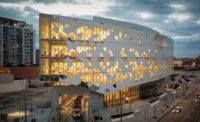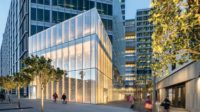San Francisco, California
As a tagline, “building better libraries for stronger communities” might be a little trite, but it does sum up San Francisco’s ambitions for its branch-improvement program — an ongoing building campaign funded in part by a $105.9 million bond passed by city voters in 2000. The 24 renovated or newly constructed branch libraries that will ultimately result from this program strive to be more than just places to borrow the latest New York Times best seller or surf the Internet. They are intended to serve as community hubs, offering events as diverse as cooking demonstrations, English classes for recent immigrants, or computer instruction.
These aspirations were very much on the minds of the architects responsible for a branch on a corner lot on Ocean Avenue, the Ingleside neighborhood’s main commercial strip. Even though the $3.5 million building, which opened in September 2009, was to be only one story tall and just over 6,000 square feet, “we wanted to give it a civic presence,” says Anne Fougeron, principal of the eponymous firm that designed the library along with Group 4 Architecture.
To distinguish the library from the surrounding jumble of one- and two-story structures that include everything from residential buildings to fast-food restaurants to auto repair shops, designers enclosed the various programmatic elements in discrete, but attached, mostly wood-framed volumes clad in stucco and tile. The 22-foot-tall children’s reading room, egg-shaped in plan, anchors the southwest corner. Two shorter, boxlike wings extend from the taller volume at right angles. One houses administrative functions and the main reading room, while the other contains a teen area and a room for special events. The roof capping the egg stretches out on steel pipe columns to shelter the main entry and seemingly hovers several feet above the Ocean Avenue–facing wing’s actual weatherproof enclosure. The idea was to endow the building with a “grander scale” that belies its true size, explains Fougeron.
Judging from the photos, the strategy works well in strong sunlight, when the building’s various surfaces are rendered by shade and shadow, making the edges of the secondary roof and of other projecting facade elements pop. But on a gray day (like the one when this reporter visited) the elevations appear flat, despite the building’s sculptural qualities. In the absence of shadow, some pieces, like metal grillwork surrounding the top of the egg, seem superfluous.
If the exterior is a bit disappointing (except under certain atmospheric conditions), the interiors are uncluttered and cleanly modern, with tightly coordinated components. The operable skylights over the main reading room offer one example of this integration. They are a key part of the building’s natural ventilation system and they allow daylight to provide the primary source of illumination. But for those times when daylight is not sufficient, designers devised cross-shaped luminaires that they incorporated into the ceiling openings, eliminating the need for potentially visually obtrusive pendant fixtures.
Finishes are basic, with a material palette dominated by gray linoleum and white-painted drywall. Even the children’s reading room, except for apple-green seating built into a bay window, has few instances of bold color. Instead, the architects have created interest with the curved walls and an amoeba-shaped light diffuser suspended below an oculus in the ceiling — elements that Fougeron refers to as “little moments to spark a child’s imagination.”
In the reading room, a set of mahogany-veneer, windowed nooks that face a small outdoor courtyard provide visual warmth. Because the nooks penetrate the exterior wall like a giant piece of indoor-outdoor furniture, they afford a transition between the interior and the court — a space intended both for solitary reading and community events.
On the chilly July afternoon when record was at Ingleside, the courtyard was empty, but almost every seat inside was taken. This popularity might be due to the free Internet access, but it seems just as likely that patrons are drawn to the library’s modest but thoughtful interior environment.
Location:
1298 Ocean Avenue
San Francisco, CA 94112
Completion Date:September 2009
Gross square footage: 6,100 sq.ft.
Total construction cost: $3.5 million
People
Owner
Architect
Personnel in architect's firm who should receive special credit: Project Manager: Todd Aranaz Design Team: Ryan Jang, Bassel Samaha (AIA), Michael Pierry (AIA), Vivian Dwyer (AIA)
Associate architect(s)
Structural:
Electrical:
Civil:
Consultant(s)
Technology:
General contractor
Construction Manager
Photographer(s)
Renderer(s)
CAD system, project management, or other software used |
Products
Exterior cladding Metal/glass curtainwall: Kawneer Aluminum Powder Coated White Wood: Mahogony EIFS, ACM, or other: Painted Stucco
Roofing Metal: Linden 05300 Metal Decking
Windows
Glazing Skylights: Acralight Custom Skylights
Doors Sliding doors: Hafele Top-Hung Junior
Hardware Hinges: BLUM B71-658 Pulls: Schlage L-Series Cabinet hardware: Armkea C-Pull 4”
Interior finishes Suspension grid: Rulon Panel Grille Suspended Wood System Paints and stains: Dunn Edwards, Pantone, Benjamin Moore Wallcoverings: Georgia-Pacific DensGlass Ultra Gypsum Plastic laminate: Dupont Corian Regular & Illumination Series Special surfacing: Abet Laminati 285, 286, 868, 909 Floor and wall tile (cite where used): Dal-Tile Mosaic (Floor) & Semi-Gloss (Wall) – Bathrooms Resilient flooring: Forbo Marmoleum Fresco 3860 Raised flooring: ASM FS-Series & S-Series
Furnishings
Chairs: Herman Miller Eames Molded Ply, Midlands Kestrel Chair, Tables: Agati Cerino & Roland Table, Midlands Kestrel Leg-Round, Thonet Primaries, ICF Quickly Table, Baker M Collection
Other furniture (use additional sheet if necessary):
Lighting Downlights: Cooper Lighting Lumark Falcon Task lighting: Birchwood Lighting WP System, LightCorp LED Sprout
Plumbing |










